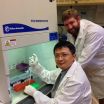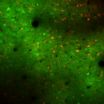(Press-News.org) Chicago, IL (May 4, 2014) — Despite being of a healthier weight, lean patients with nonalcoholic fatty liver disease (NAFLD) have a higher overall mortality rate than patients with NAFLD who are overweight or obese, according to new research presented today at Digestive Disease Week® (DDW). In addition to finding higher mortality rates, an international team of researchers found that lean patients [a body mass index (BMI) less than 25] with NAFLD were more likely to be male, non-Caucasian and to have lower rates of chronic conditions, such as diabetes and hypertension.
"Our comparison of lean patients and their overweight or obese counterparts gives us clues about risk factors for this disease that go beyond a person's weight," said Paul Angulo, MD, section chief of hepatology in the division of digestive diseases and nutrition at the University of Kentucky Medical Center. "These findings have implications both for future research and for current standards of care. We must not assume that patients of relatively healthy weight can't have fatty liver disease."
The retrospective study is the first of its kind in detailing the characteristics of a large number of lean patients with NAFLD. The study examined more than 20 years' worth of clinical and laboratory data of more than 1,000 patients with biopsy-confirmed NAFLD. Lean patients had an average BMI of 23 and the non-lean group had an average BMI of 33.
The lean group had significantly less insulin resistance as well as lower levels of a liver enzyme called alanine aminotransferase (ALT) that correlates with liver damage. And while lean patients had a lower degree of fatty deposits on the liver and less advanced fibrosis, these patients showed more severe inflammation of the liver.
Of the 1,090 patients, liver biopsy was done before 2005 in 483 patients. In this subgroup, nine of the 32 (28 percent) lean patients died compared to 62 of the 451 (14 percent) overweight or obese patients. In examining the specific cause of mortality, researchers did not find any differences between the two groups.
"About 30 percent of the U.S. population suffers from NAFLD, and the prevalence of this condition is increasing. Although we often associate fatty liver disease with obese patients, these results suggest that possible signs of liver disease secondary to NAFLD in lean patients should be taken very seriously," said Dr. Angulo.
Dr. Angulo and his team plan to expand on their findings about this specific patient population by examining data beyond BMI, including fat distribution and differences in cell signaling proteins, such as cytokine and adipokine profiles. They also plan to include patients who have not yet had a liver biopsy.
Dr. Paul Angulo will present data from the study "Characteristics and long-term prognosis of lean patients with nonalcoholic fatty liver disease," abstract 379, on Sunday, May 4, at 2:45 p.m. CT, in room S405A of McCormick Place. For more information about featured studies, as well as a schedule of availability for featured researchers, please visit http://www.ddw.org/press.
INFORMATION:
About DDW
Digestive Disease Week® (DDW) is the largest international gathering of physicians, researchers and academics in the fields of gastroenterology, hepatology, endoscopy and gastrointestinal surgery. Jointly sponsored by the American Association for the Study of Liver Diseases (AASLD), the American Gastroenterological Association (AGA) Institute, the American Society for Gastrointestinal Endoscopy (ASGE) and the Society for Surgery of the Alimentary Tract (SSAT), DDW takes place May 3-6, 2014, at McCormick Place, Chicago. The meeting showcases more than 5,000 abstracts and hundreds of lectures on the latest advances in GI research, medicine and technology. More information can be found at http://www.ddw.org.
Follow us on Twitter @DDWMeeting; hashtag #DDW14. Become a fan of DDW on Facebook. END
Lean patients with fatty liver disease have higher mortality rate
Study takes first look at lean patients' long-term prognosis
2014-05-04
ELSE PRESS RELEASES FROM THIS DATE:
Arizona Sate University scientists take steps to unlock the secrets to the fountain of youth
2014-05-04
ASU scientists, together with collaborators from the Chinese Academy of Sciences in Shanghai, have published today, in Nature Structural and Molecular Biology, a first of its kind atomic level look at the enzyme telomerase that may unlock the secrets to the fountain of youth.
Telomeres and the enzyme telomerase have been in the medical news a lot recently due to their connection with aging and cancer. Telomeres are found at the ends of our chromosomes and are stretches of DNA which protect our genetic data, make it possible for cells to divide, and hold some secrets as ...
Study unveils new approach to treating brittle bone disease
2014-05-04
HOUSTON – (May 4, 2014) – Researchers at Baylor College of Medicine have identified a new approach to treating brittle bone disease, a congenital disorder that results in fragile bones that break easily.
The study, published in the current issue of the journal Nature Medicine, showed that excessive activity of an important signaling protein in the matrix of the bone called transforming growth factor beta is associated with the cause of the disease.
"There are many genetic causes of brittle bone disease in children and adults," said Dr. Brendan Lee, professor of molecular ...
New method for measuring the temperature of nanoscale objects discovered
2014-05-04
Temperature measurements in our daily life are typically performed by bringing a thermometer in contact with the object to be measured. However, measuring the temperature of nanoscale objects is a much more tricky task due to their size - up to a thousand times smaller than the width of a human hair.
Pioneering research, published in Nature Nanotechnology, has now developed a method to accurately measure the surface temperature of nanoscale objects when they have a different temperature than their environment. A team led by Dr Janet Anders at the University of Exeter ...
New insight may help predict volcanic eruption behavior
2014-05-04
VIDEO:
Using friction experiments University of Liverpool scientists have shown that frictional melting plays a role in determining how a volcano will erupt.
Click here for more information.
A new discovery in the study of how lava dome volcanoes erupt may help in the development of methods to predict how a volcanic eruption will behave, say scientists at the University of Liverpool.
Volcanologists at the University have discovered that a process called frictional melting plays ...
Functioning of aged brains and muscles in mice made younger
2014-05-04
Cambridge, MA, May 4 - Harvard Stem Cell Institute (HSCI) researchers have shown that a protein they previously demonstrated can make the failing hearts in aging mice appear more like those of young health mice, similarly improves brain and skeletal muscle function in aging mice.
In two separate papers given early online release today by the journal Science – which is publishing the papers this coming Friday, Professors Amy Wagers and Lee Rubin, of Harvard's Department of Stem Cell and Regenerative Biology (HSCRB), report that injections of a protein known as GDF11, which ...
New study sheds light on global warming trends
2014-05-04
TALLAHASSEE, Fla. — New research by a team of Florida State University scientists shows the first detailed look at global land surface warming trends over the last 100 years, illustrating precisely when and where different areas of the world started to warm up or cool down.
The research indicates that the world is indeed getting warmer, but historical records show that it hasn't happened everywhere at the same rate.
And that new information even took scientists by surprise.
"Global warming was not as understood as we thought," said Zhaohua Wu, an assistant professor ...
Motor cortex shown to play active role in learning movement patterns
2014-05-04
Skilled motor movements of the sort tennis players employ while serving a tennis ball or pianists use in playing a concerto, require precise interactions between the motor cortex and the rest of the brain. Neuroscientists had long assumed that the motor cortex functioned something like a piano keyboard.
"Every time you wanted to hear a specific note, there was a specific key to press," says Andrew Peters, a neurobiologist at UC San Diego's Center for Neural Circuits and Behavior. "In other words, every specific movement of a muscle required the activation of specific ...
Taking the lead out of a promising solar cell
2014-05-04
Northwestern University researchers are the first to develop a new solar cell with good efficiency that uses tin instead of lead perovskite as the harvester of light. The low-cost, environmentally friendly solar cell can be made easily using "bench" chemistry -- no fancy equipment or hazardous materials.
"This is a breakthrough in taking the lead out of a very promising type of solar cell, called a perovskite," said Mercouri G. Kanatzidis, an inorganic chemist with expertise in dealing with tin. "Tin is a very viable material, and we have shown the material does work ...
Study points to potential revision of treatment guidelines for bleeding ulcers
2014-05-04
Chicago, IL (May 4, 2014) — The current standard of care for managing patients who receive endoscopic treatment for bleeding ulcers should be replaced by an equally safe and less costly alternative that is more comfortable for patients, according to new research presented today at Digestive Disease Week® (DDW). Researchers at the Yale University School of Medicine compared the current recommended care plan — delivering an initial dose of proton pump inhibitor (PPI) followed by continuous PPI infusion — to a regimen using only intermittent PPI therapy, which was found to ...
Weight-loss surgery can reduce liver damage
2014-05-04
Chicago, IL (May 4, 2014) — Bariatric surgery, which is best known for its ability to help patients lose substantial weight, can also result in significant improvement in nonalcoholic fatty liver disease (NAFLD), according to new research presented today at Digestive Disease Week® (DDW). Researchers at the University of South Florida-Tampa found that bariatric surgery resolved liver inflammation and reversed early-stage liver fibrosis, the thickening and scarring of liver tissue, by reducing fat deposits in the liver.
"About 30 percent of the U.S. population suffers ...
LAST 30 PRESS RELEASES:
Scientists to ‘spy’ on cancer- immune cell interactions using quantum technology breakthrough
Tech savvy users have most digital concerns
Making lighter work of calculating fluid and heat flow
Normalizing blood sugar can halve heart attack risk
Lowering blood sugar cuts heart attack risk in people with prediabetes
Study links genetic variants to risk of blinding eye disease in premature infants
Non-opioid ‘pain sponge’ therapy halts cartilage degeneration and relieves chronic pain
AI can pick up cultural values by mimicking how kids learn
China’s ecological redlines offer fast track to 30 x 30 global conservation goal
Invisible indoor threats: emerging household contaminants and their growing risks to human health
Adding antibody treatment to chemo boosts outcomes for children with rare cancer
Germline pathogenic variants among women without a history of breast cancer
Tanning beds triple melanoma risk, potentially causing broad DNA damage
Unique bond identified as key to viral infection speed
Indoor tanning makes youthful skin much older on a genetic level
Mouse model sheds new light on the causes and potential solutions to human GI problems linked to muscular dystrophy
The Journal of Nuclear Medicine ahead-of-print tip sheet: December 12, 2025
Smarter tools for peering into the microscopic world
Applications open for funding to conduct research in the Kinsey Institute archives
Global measure underestimates the severity of food insecurity
Child survivors of critical illness are missing out on timely follow up care
Risk-based vs annual breast cancer screening / the WISDOM randomized clinical trial
University of Toronto launches Electric Vehicle Innovation Ontario to accelerate advanced EV technologies and build Canada’s innovation advantage
Early relapse predicts poor outcomes in aggressive blood cancer
American College of Lifestyle Medicine applauds two CMS models aligned with lifestyle medicine practice and reimbursement
Clinical trial finds cannabis use not a barrier to quitting nicotine vaping
Supplemental nutrition assistance program policies and food insecurity
Switching immune cells to “night mode” could limit damage after a heart attack, study suggests
URI-based Global RIghts Project report spotlights continued troubling trends in worldwide inhumane treatment
Neutrophils are less aggressive at night, explaining why nighttime heart attacks cause less damage than daytime events
[Press-News.org] Lean patients with fatty liver disease have higher mortality rateStudy takes first look at lean patients' long-term prognosis




